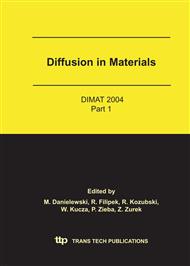p.257
p.266
p.271
p.277
p.282
p.291
p.303
p.317
p.322
Tracer Diffusion and Ionic Conduction in Standard Silica Glasses
Abstract:
The tracer diffusivities of 22Na and 45Ca in two high-quality standard silica glasses have been measured in the temperature range between 473 and 783 K. The temperature dependences of the tracer diffusion coefficients in both glasses follow Arrhenius laws. The diffusion of 22Na is six to seven orders of magnitude faster than the diffusion of 45Ca. The ionic conductivity was determined by impedance spectroscopy and the conductivity diffusion coefficient Ds was deduced from the dc conductivity via the Nernst-Einstein relation. The temperature dependences of Ds for both glasses follow also Arrhenius functions. The activation parameters and pre-exponential factors for tracer diffusion and for conductivity diffusion were determined. The activation enthalpy of 22Na diffusion is almost equal to the activation enthalpy of the dc conductivity. We conclude that the conductivity of standard glasses is due to the motion of Na ions. The diffusivities of 22Na and 45Ca in soda-lime glasses increase with increasing Na2O content.
Info:
Periodical:
Pages:
282-290
Citation:
Online since:
April 2005
Authors:
Price:
Сopyright:
© 2005 Trans Tech Publications Ltd. All Rights Reserved
Share:
Citation:


